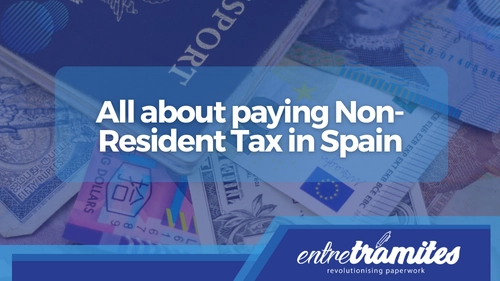The non-resident tax in Spain is a fundamental aspect of the tax system, especially for those who do not permanently reside in the country but generate income or own property in Spanish territory. In this article, we will provide you with a complete guide on how to pay non-resident tax in Spain in 2023.
Who must pay the Non-Resident Tax?
The non-resident tax in Spain applies to individuals who do not have tax residence in Spain, but who generate income within the country. This may include:
- Property Owners in Spain: If you own property in Spain, whether a holiday home or an investment, you will likely have to pay this tax.
- Real Estate Investors: If you have earned income from renting a property in Spain, you must pay the non-resident tax.
- Investors in Spanish Shares: If you own shares or stocks of Spanish companies, you may have to pay this tax on the profits obtained.
- Non-Residents with Other Income: If you are a non-resident and earn income in Spain, such as earnings from economic or professional activities, you may also be subject to non-resident tax.
How to pay the Non-Resident Tax in Spain?
- Obtain your Non-Resident Identification Number (NIE): If you do not already have an NIE, you must obtain one at a Spanish police station or at a Spanish consulate in your home country. This number is necessary for any tax procedure in Spain.
- Determine your Tax Base: To calculate your non-resident tax, you must determine your tax base. In the case of properties, this base is established using the property’s assessed value and a specific tax rate.
- Complete Form 210: The non-resident tax is declared and paid through Form 210. This form must be completed electronically through the web portal of the Spanish Tax Agency or physically presented at an authorized financial entity.
- Calculate the Tax Debt: Once you have entered the necessary information in Form 210, the system will automatically calculate the tax debt. This is the amount you must pay to the Spanish treasury.
- Make the Payment: You can pay the non-resident tax in Spain through a bank transfer or directly at an authorized financial institution. Please ensure you provide the correct reference number so the payment is applied correctly.
- Submit Form 210: Once you have completed the form and made the payment, you must submit Form 210 before the deadline. The deadline to file this tax generally extends until December 31 of the year following the year in which the declaration corresponds.
Helpful tips
- Keep Detailed Records: Keep complete records of all transactions and documents related to your income in Spain, such as rental agreements, invoices, and receipts.
- Calculate in Advance: Plan ahead and make sure you have enough funds to pay the non-resident tax on the corresponding dates.
- Professional Advice: If you feel overwhelmed by the process or have specific questions about your tax situation, consider consulting a tax advisor or lawyer with experience in Spanish taxes.
Complying with your tax obligations as a non-resident in Spain is essential to avoid legal problems and sanctions. While the process may seem complicated at first, with the right guidance and documentation in order, you can effectively manage the payment of non-resident tax in Spain in 2023.
Do you need more information about non-resident tax in Spain?
At Entre Trámites we offer various services of management, advice, and support in bureaucratic procedures for self-employed, SMEs, and other types of companies. Contact us! Through our contact form, you can leave your details for us to call you, schedule a free consultation, or simply text our WhatsApp.





